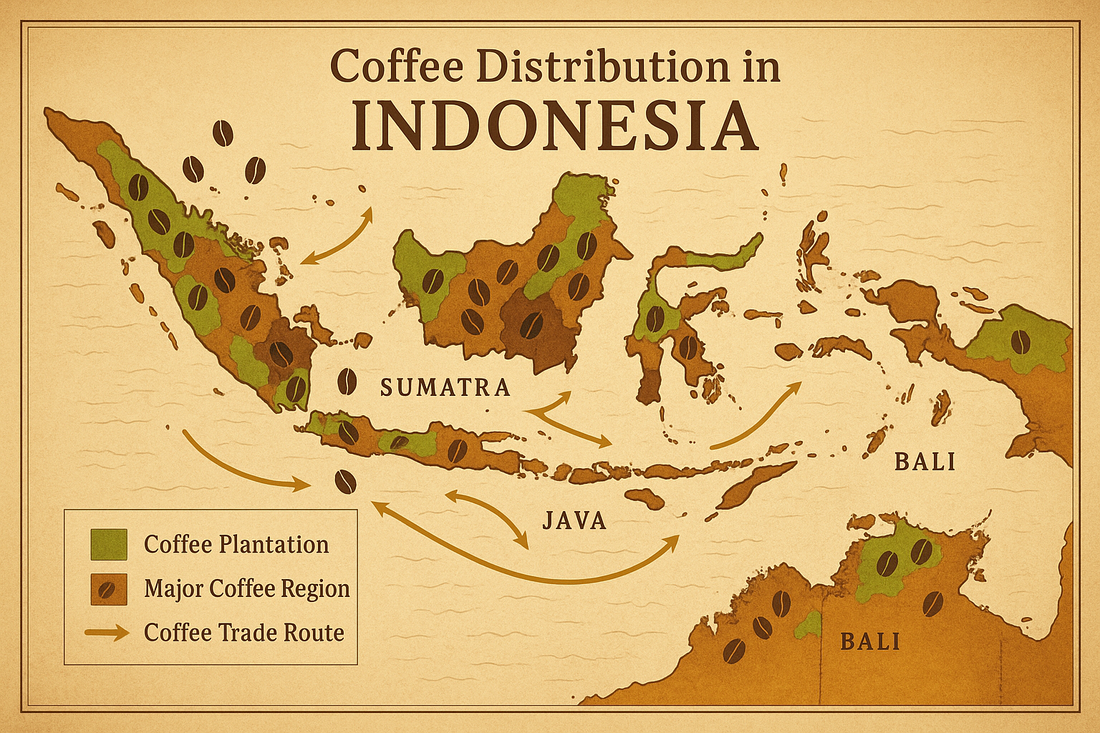
A Journey Through Time: The Rich History of Coffee in Indonesia
Share
Indonesia's journey as a coffee powerhouse is a fascinating tale interwoven with its colonial past, agricultural innovation, and cultural heritage. Today, it stands as the world's third-largest coffee producer, celebrated for its unique and full-bodied single-origin coffees. The story begins over three centuries ago, when coffee first took root in the archipelago.
The Arrival of Coffee (Late 17th Century)
Coffee was first introduced to Indonesia by the Dutch East India Company (VOC). The Dutch, seeking to break the Arab monopoly on the global coffee trade, successfully smuggled Arabica coffee seedlings out of Yemen and first planted them in Ceylon (now Sri Lanka). The first successful cultivation in Indonesia began in 1696 in the region of Batavia (modern-day Jakarta). The plants thrived in the fertile volcanic soil and ideal climate, and by 1711, the VOC had begun exporting the first Indonesian coffee from the island of Java.

This initial success was so significant that "Java" became a popular synonym for coffee around the world, a testament to the island's early dominance in the market.
Expansion and Forced Cultivation (18th - 19th Century)
As the demand for coffee grew, the Dutch expanded cultivation across the archipelago. They established vast plantations on other islands with suitable climates, including Sumatra, Sulawesi, and Bali. To maximize production and profit, the Dutch implemented a system of forced cultivation known as cultuurstelsel (Cultivation System) in the mid-19th century. Under this oppressive policy, Javanese farmers were forced to dedicate a portion of their land to growing coffee and other cash crops for export to Europe. This system turned Indonesia into a massive coffee producer but came at a great cost to the local population.
The Rust Plague and the Rise of Robusta
In the 1870s, a devastating coffee leaf rust plague (Hemileia vastatrix) swept through Indonesia, wiping out nearly all of the Arabica coffee plants. The disease, which originated in Ceylon, forced the Dutch to seek a more resilient alternative. They introduced Robusta coffee (Coffea canephora) to the islands. Robusta, known for its disease resistance, higher yield, and higher caffeine content, quickly took over and became the dominant variety, especially in lower-altitude areas. Today, Robusta accounts for the majority of Indonesia's total coffee production.
The Modern Era: From Commodity to Specialty
After Indonesia gained independence, the old colonial plantations were nationalized and eventually transitioned to government or private ownership. In the late 20th century, there was a renewed focus on reviving the premium Arabica varieties. Farmers began preserving and cultivating unique heirloom species, leading to a renaissance in specialty coffee.
This modern era is defined by several key developments:
Unique Processing Methods: Indonesian farmers perfected unique methods like giling basah (wet-hulling), particularly in Sumatra. This semi-washed process gives the coffee a full body, low acidity, and a distinctive earthy flavor that is highly prized by connoisseurs.
Single-Origin Excellence: Regions like Sumatra (Mandheling, Lintong), Sulawesi (Toraja), Bali (Kintamani), and Papua (Wamena) gained international fame for their unique flavor profiles, each reflecting the specific terroir of their growing region.
Cultural Significance: Coffee has become deeply embedded in Indonesian culture, from bustling street-side stalls serving strong, sweet coffee to the flourishing modern cafe scene in major cities.
A Legacy of Diversity
From the forced labor of the colonial era to the global recognition of its specialty beans, Indonesia's coffee history is a complex and compelling one. The combination of its tropical climate, volcanic soil, and a rich heritage of agricultural practices has given birth to an extraordinary diversity of flavors. Today, every cup of Indonesian coffee tells a story of survival, resilience, and the relentless pursuit of quality that has made it a true gem in the world of coffee.
